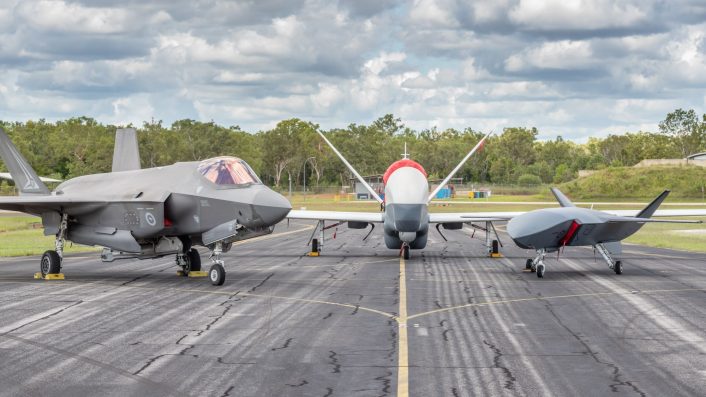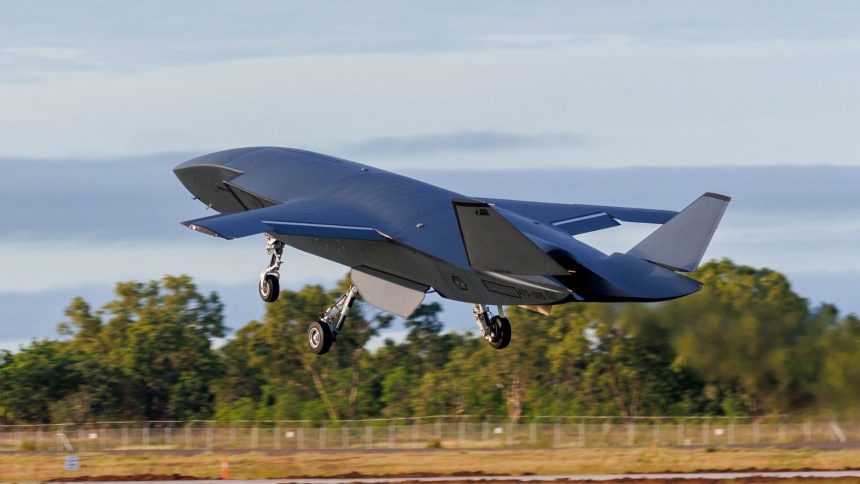Boeing Defence Australia and the RAAF conducted a series of significant trials by teaming the Ghost Bat with the service’s major platforms, and will now conduct a live fire test.
The live-fire test of an air-to-air missile launched from the MQ-28A Ghost Bat CCA (Collaborative Combat Aircraft), that Boeing Defence Australia officials previously announced, is slated for next month, December 2025. The company previously disclosed in March that the test was planned between late 2026 and early 2026.
Steven Parker, president of Boeing Defense Space and Security, also identified the missile as the AIM-120 AMRAAM while speaking to journalists at the Dubai Airshow. This would make the ACP (Autonomous Collaborative Platform) possibly the first loyal wingman UCAV to conduct an air-to-air missile firing.
Parker had first revealed the AAM test at the Avalon Australian Air Show in March. The War Zone quoted Parker from the media interaction ahead of the Dubai Airshow: “At the Avalon Air Show in Australia in March, I talked about doing a weapons shot off the MQ-28 later this year, or early in 2026. We are on track for next month. This weapon shot is something we’re really excited about. It’s an air-to-air missile, and if you were to guess it was an AMRAAM, AIM-120, you would be correct.”
✅Find ✅Fix ✅Track ✅Target
Tasked by the @AusAirForce, we proved the MQ‑28 can execute these critical air‑combat steps — ahead of schedule. Collaborative combat aircraft flying with crewed platforms means better threat awareness, faster decisions and safer crews.
More:… pic.twitter.com/tX50cs3Jz5
— Boeing Australia (@BoeingAustralia) September 5, 2025
Ghost Bat and air-to-air missile test
It is unclear if the Ghost Bat has already been put through a captive carry trial of a representative test article of the missile, usually an inert training round, as is the standard practice while integrating air-launched weapons and carrier aircraft – both manned and unmanned. We also do not know what kind of internal weapons stores the MQ-28A has.
Parker explained that the test will be carried out at the Woomera Range Complex in a “tactically relevant scenario.” In a recent photograph showing our of the Block 1 MQ-28A Ghost Bats, two have what has been assessed to be IRST (Infra-Red Search and Track) sensors, which might play a part in the targeting during the test.

Other concept illustrations have shown the Ghost Bat’s nose to be swappable, with payloads for ISR and electronic warfare/electronic intelligence roles. The live AMRAAM test will most likely be against a pilot-less target drone, and will demonstrate an elementary off-board sensing and off-board weapons release capability.
Whether other assets like the RAAF’s E-7A Wedgetail, the MQ-4C Triton, the F-35A Lightning II or the EA-18G Growler would also be used, remains to be seen. Nevertheless, the ability of the UCAV to employ air-to-air missiles allows bringing the much required mass in a conventional war with a peer adversary and aids creating dilemmas for adversary fleets, enhancing both situational awareness and dictating the pace and tempo of operations.
Testing progress
Boeing Defence Australia and the RAAF have demonstrated the MQ-28A’s ability to network and coordinate with the E-7, MQ-4C, F-35 and EA-18G in previous tests, bearing the rapid pace at which the unmanned system is progressing.
Royal Australian Air Force begins training first pilots to operate MQ-28A Ghost Bat Loyal Wingman droneshttps://t.co/agFoHdETlc pic.twitter.com/qFj7U0Fymu
— Roni Sontani (@Roni_Sont) August 26, 2024
The most significant of these was the test that Boeing announced in June, where two Ghost Bats teamed up with an E-7A Wedgetail and conducted a mission against a simulated airborne target while being controlled by an operator aboard the E-7. The AI-enabled Ghost Bat is already capable of autonomous operations like taxiing, take-off and landing.
Prior to that, in April, the RAAF and Boeing tested the Ghost Bat for a week at RAAF Tindal in the Northern Territory, marking the first time it operated outside the Woomera Training Area in South Australia, where it exclusively operated since the first flight.
During Exercise Carlsbad, images and video released by Boeing and the Australian Department of Defence showed the Ghost Bat with the RAAF’s F-35A and Triton. Boeing had previously said during the test with the Wedgetail that future events would also include the F/A-18F and F-35 fighters.
Flight of the Ghost Bat! ✈️👻🦇
The MQ-28A Ghost Bat achieved first flight outside of Woomera Training area during Exercise Carlsbad.
Ghost Bat is the first military aircraft designed and built in Australia in more than 50 years. #YourADF pic.twitter.com/mO3Y0upyB6
— Defence Australia (@DefenceAust) June 21, 2025
Concept illustrations from Boeing have shown the Ghost Bat flying with the E-7A Wedgetail, beside the F-15EX and the EA-18G Growler. Boeing says the AI-enabled Ghost Bat can “work as a smart team with existing military aircraft to complement and extend airborne missions.”
It could also serve in an escort role for high-value support assets such as the E-7A or KC-30 aerial refueler. Generally, the MQ-28A is meant to “to team with crewed platforms performing mission roles and responsibilities typical of fighter aircraft, complementing and extending airborne missions while increasing situational awareness and survivability,” the Australian Department of Defence explained.

The RAAF’s operational concept revolves around fusing its airborne electromagnetic sensing platforms like the Wedgetail, MC-55A Peregrine SIGINT aircraft, the Growler and F-35A into a single network, with the Ghost Bat now emerging to be an important element in this node.
The DSR acknowledges the importance of the MQ-28A Ghost Bat to our air domain.
As the first military combat aircraft in 50 years to be designed, engineered & manufactured in 🇦🇺 #AusAirForce recognises how our #STEMProfessionals are enhancing Air Force capability.#scienceweek pic.twitter.com/3wsTrPeYtw
— Air Marshal Stephen Chappell (@CAF_Australia) August 16, 2023
Future
The RAAF and Boeing have validated a basic MUM-T capability of the Ghost Bat with its leading platforms would greatly enhance its prospects for international customers.
TWZ further quoted Parker, who shared some more details about the status of the program: “I’m not going to get ahead of the customer here, but we’re well positioned for this. We’ve been sort of testing out some of these capability demonstrations. You would know that the Wedgetail [Boeing’s E-7 airborne early warning and control aircraft] has already controlled two live MQ-28s with a digital, virtual MQ-28 in the pattern, as well, [and] with a target. So, we’ve already been doing a bunch of multi-ship activities.”
The U.S. Air Force itself is a potential customer, and has previously received at least one Ghost Bat for testing, which Boeing hoped would translate into an acquisition. The U.S. Navy meanwhile recently chose Boeing, along with Anduril, Lockheed Martin and General Atomics, to produce conceptual designs for carrier-borne CCAs.
Take a peek into the future.
With the F-15EX’s future manned-unmanned teaming capabilities supported by an advanced cockpit system, communication networks and two-seat configuration, the superior fighter could serve as a battle manager and joint all domain command and control. pic.twitter.com/07oRhGdIjV
— Boeing Defense (@BoeingDefense) September 4, 2025
The December 2025 live-fire test, if successful, would tip the scales in Ghost Bat’s favor commercially, as it is set to compete with the YFQ-44A, YFQ-42A and the XQ-58 Valkyrie.









